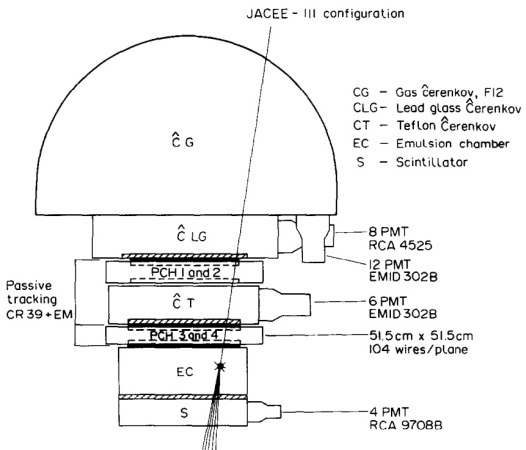Purpose of the flight and payload description
The Japanese American Collaborative Emulsion Experiment (JACEE) was a scientific effort carried out to measure the composition and spectra of primary cosmic rays at the top of the atmosphere, using emulsion chambers transported by stratospheric balloons. JACEE's first flight was conducted in 1979, and flights continued through 1996, totaling 14 flights and 13 successful missions. The collaboration leveraged Japanese expertise in photographic materials and microscopy, American expertise in ballooning and data analysis, and Polish resources in scanning and measurement of emulsions.
Each payload could contain one, three, or four chambers, each chamber with an area about 2000 cm2, 12~25 cm thick, and weighing ~120 kg. Figure at left shows a schematic diagram of the vertical configuration of one chamber. It was comprised of four sections, identifiable according to their function in the experiment. These are, from the top, the charge detector, the target, the spacer, and the calorimeter. All sections were multilayered stacks of track-sensitive materials (emulsions, x-ray films, CR-39, Lexan) alternated with absorbers (acrylic, lead). There were approximately 300 layers of emulsion in the chamber. This configuration was more or less the same for all the flights. However, many flights not included the spacer section, and in some cases were added other elements like Cerenkov detectors or plastic scintillators.
The charge detector employed thick (200 - 400 micron) emulsions, which permited accurate determination of the charge of each primary particle via measurements of the grain density, gap distribution, and/or delta ray distribution. The target section was comprised basically of thin (50 ~ 75 micron) emulsion plates alternated with acrylic sheets. The substantial mass of low-Z material maximized the interaction probability, while the emulsion optimized the observation of charged tracks from an interaction vertex. In order to identify nuclear fragments, charge identification layers composed of thick emulsions and etchable plastics were inserted at regular intervals throughout the target.
The spacer section consisted of honeycomb paper with a few thin emulsions positioned at regular intervals that facilitated the tracing of tracks through it. Finally, the calorimeter was the energy measuring portion of the apparatus. It consisted of 1.0 and 2.5 mm thick lead sheets alternating with thin emulsion plates and x-ray films. Gamma rays emanating from a vertex in the target initiated electro-magnetic cascades in the calorimeter. The cascades produced dark spots in the x-ray films, the observation of which provided the trigger for an event. The events were traced back from the calorimeter, through the spacer, to the vertex in the target by observing associated tracks in the emulsions.
Details of the balloon flight
Balloon launched on: 6/2/1982 at 23:41 utc
Launch site: Donaldson Center, Greenville, South Carolina, US
Balloon launched by: National Scientific Balloon Facility (NSBF)
Balloon manufacturer/size/composition: Zero Pressure Balloon Winzen 502.344 m3 (15.24 microns Stratofilm)
Balloon serial number: W17.74-2-01
Flight identification number: 186N
End of flight (L for landing time, W for last contact, otherwise termination time): 6/4/1982 at 18:01 utc
Balloon flight duration (F: time at float only, otherwise total flight time in d:days / h:hours or m:minutes - ): 47 h
Landing site: 28 miles E of Roswell, New Mexico, US
Payload weight: 1633 kgs.
This third mission of the project employed a rather different configuration than in previous flights using electronic counters in conjunction with the emulsion chamber. A freon gas Cerenkov counter provided primary energy information over the range 20 - 60 GeV/nucleon. Two solid Cerenkov radiators, teflon and lead glass, provided charge measurements for medium and heavy nuclei. Proportional counter hodoscopes provided primary trajectory information. These counters were located upstream from the emulsion chamber. A scintillator located downstream acted as a burst counter. The objectives of the JACEE-3 flight included studying nucleus-nucleus interactions for known primary energies and charges, as well as calibration measurements for the passive exposures.
A similar version of this instrument was later flown as a Space Shuttle Hitchhiker.
External references
- JACEE experiment website Institute of Nuclear Physics PAN, Poland
- JACEE experiment website University of Washington Particle Astrophysics Group
- Cosmic-Ray Proton and Helium Spectra: Results from the JACEE Experiment Astrophysical Journal Vol. 502 Pag 278, 1998
- Elemental abundance of high energy cosmic rays Nuclear Physics B - Proceedings Supplements - Vol. 60, Issue 3, p. 83
- National Scientific Balloon Facility Annual Report FY 1982 National Center for Atmospheric Research, February 1983
- Flight Summary of balloons made of Stratofilm - 1981 to 1983, Technical report, Winzen Research International. Circa 1984 - Stratocat's private collection
4575If you consider this website interesting or useful, you can help me to keep it up and running with a small donation to cover the operational costs. Just the equivalent of the price of a cup of coffee helps a lot.


